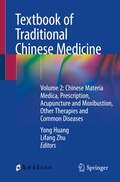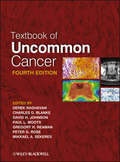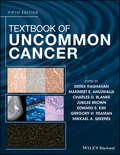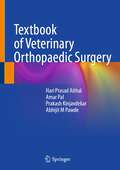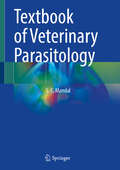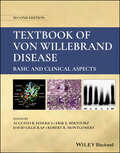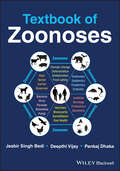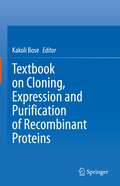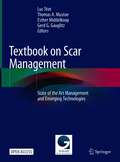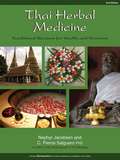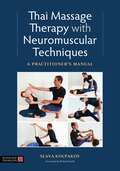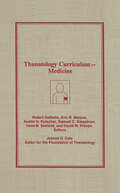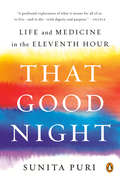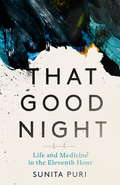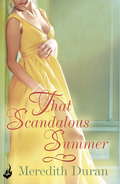- Table View
- List View
Textbook of Tinnitus
by Aage R. Møller Dirk Deridder Tobias Kleinjung Berthold LangguthGroundbreaking, comprehensive, and developed by a panel of leading international experts in the field, Textbook of Tinnitus provides a multidisciplinary overview of the diagnosis and management of this widespread and troubling disorder. Importantly, the book emphasizes that tinnitus is not one disease but a group of rather diverse disorders with different pathophysiology, different causes and, consequently, different treatments. This comprehensive title is written for clinicians and researchers by clinicians and researchers who are active in the field. It is logically organized in six sections and will be of interest to otolaryngologists, neurologists, psychiatrists, neurosurgeons, primary care clinicians, audiologists and psychologists. Textbook of Tinnitus describes both the theoretical background of the different forms of tinnitus and it provides detailed knowledge of the state-of-the-art of its treatment. Because of its organization and its extensive subject index, Textbook of Tinnitus can also serve as a reference for clinicians who do not treat tinnitus patients routinely.
Textbook of Tinnitus
by Sven Vanneste Aage R. Møller Tobias Kleinjung Berthold Langguth Dirk De Ridder Winfried SchleeThis book describes the theoretical background of the different forms of tinnitus (ringing in the ears) and detailed knowledge of state-of-the-art treatments of tinnitus. Tinnitus has many forms, and the severity ranges widely from being non-problematic to severely affecting a person’s daily life. How loud the tinnitus is perceived does not directly relate to how much it distresses the patient. Thus, even tinnitus very close to the hearing threshold can be a disabling symptom. It can reduce the quality of life by generating anxiety and concentration problems, impairing the ability to do intellectual work, making it difficult to sleep, causing depression and sometimes even leading to suicide.Textbook of Tinnitus has filled a void by providing a comprehensive overview about the different forms of tinnitus, their pathophysiology and their treatment. However, since the publication of the first edition of the Textbook of Tinnitus in 2011, tinnitus research has dramaticallyevolved. In view of the substantial increase in knowledge, most chapters in this second edition are newly written and a few original chapters have had major updates. This edition has nine sections, covering the basics of tinnitus, the neurobiology of tinnitus, pathophysiological models, animal research, diagnosis and assessment, various forms of management and treatment, and finally, a look at the future of tinnitus and tinnitus research. The book will be of great interest to otolaryngologists, neurologists, psychiatrists, neurosurgeons, primary care clinicians, audiologists and psychologists, and students. Because of its organization and its extensive subject index, Textbook of Tinnitus, Second Edition can also serve as a reference for clinicians who do not treat tinnitus patients routinely.
Textbook of Traditional Chinese Medicine: Volume 1: Introduction, Examination, Etiologies and Pathogenesis and Differentiation of Syndromes
by Yong Huang Lifang ZhuThis book covers all the contents from theoretical basis to clinical practice comprehensively, which are under the guideline of classic inheritance and the essence of TCM. TCM is a comprehensive discipline. In this book, philosophical foundation, physiology and pathology, etiology, differentiation and diagnostics, and health-preservation of TCM, Chinese materia medica and prescription, acupuncture and moxibustion, characteristic therapies, and common clinical disease are systematically arranged.From Chapter 1-4, a clear picture of the philosophical foundation of TCM from yin-yang, five-element, qi, blood, body fluids and zang-fu viscera theory is presented. From Chapter 5-7 include etiology, pathogenesis, diagnostic and differentiation of syndromes. Chapter 8 is one of the most popular chapters with a topic of health-preservation. Chapter 9 mainly present clinical TCM therapies of common disease.This book is a useful textbook for graduate and undergraduate students inmedical schools, including MBBS (Bachelor of Medicine and Bachelor of Surgery) student.
Textbook of Traditional Chinese Medicine: Volume 2: Chinese Materia Medica, Prescription, Acupuncture and Moxibustion, Other Therapies and Common Diseases
by Yong Huang Lifang ZhuThis book covers all the contents from theoretical basis to clinical practice comprehensively, which are under the guideline of classic inheritance and the essence of TCM. TCM is a comprehensive discipline. In this book, philosophical foundation, physiology and pathology, etiology, differentiation and diagnostics, and health-preservation of TCM, Chinese materia medica and prescription, acupuncture and moxibustion, characteristic therapies, and common clinical disease are systematically arranged.Chapter 1 and Chapter 2 are about Chinese materia medica and prescription, presenting the tropism of natures, flavors and meridians, as well as commonly used prescription. Acupuncture and moxibustion therapy is the topic of Chapter 3, meridians and acupoints and acupuncture techniques are explained systematically and thoroughly. Chapter 4 is about some particular therapies such as massage, dietary therapy, qigong and Tai Chi. Chapter 5 mainly present clinical TCM therapies of common disease. And the last is appendix which provides supplementary materials as references.This book is a useful textbook for graduate and undergraduate students in medical schools, including MBBS (Bachelor of Medicine and Bachelor of Surgery) student.
Textbook of Transplantation and Mechanical Support for End-Stage Heart and Lung Disease, 2 Volume Set
by Daniel J. Goldstein Yaron D. Barac Scott C. Silvestry Mani A. DaneshmandTextbook of Transplantation and Mechanical Support for End-Stage Heart and Lung Disease Comprehensive textbook covering all aspects of the care of patients with advanced heart or lung disease Transplantation and Mechanical Support for End-Stage Heart and Lung Disease is the most comprehensive and contemporary textbook available that addresses the medical and surgical treatment options for patients with end-stage heart and lung disease. All facets of these complex and resource-intensive therapies are covered by leading experts — including the basics of transplant immunology, databases, regulatory and ethical aspects of transplantation and conventional and new modalities of donor organ harvest. Transplantation and Mechanical Support for End-Stage Heart and Lung Disease includes further information on topics such as: Historical developments that facilitated heart and lung transplantation; engineering advances in continuous flow technologies Transplant organizations, oversight, structure, process, databases and registries in the thoracic transplants and MCS field Current strategies in immune modulation, desensitization protocols and mechanisms of allograft rejection and tolerance/immunosenescence Detailed descriptions of donor and recipient surgical procedures as well as comprehensive implantation techniques for all available short- and long-term mechanical circulatory support devices, including ECMO Organ allocation and prioritization, donor evaluation, high risk donors, marginal donors, and risk assessment Richly enhanced with summary tables and color illustrations to provide an engaging and supportive learning experience, the book will serve as a highly valuable source of contemporary knowledge for medical students, residents, nurses, perfusionists, physicians and surgeons involved in the care of these desperately ill group of patients. “This comprehensive book covers all aspects of advanced heart and lung failure treatment, including shock, short-term and durable mechanical assistance, as well as transplantation. The in-depth information will be welcome by newcomers in the field as well as seasoned veterans.” —Andreas Zuckermann, M.D Vice-Chair, Department of Cardiac Surgery, Director of Cardiac Transplantation Program, Medical University of Vienna, Vienna General Hospital “This comprehensive tour-de-force compendium covers practical issues of clinical administration, program development, care pathways, ongoing challenges and opportunities in each treatment area as a must go-to reference for guidance in the rapidly evolving fields of mechanical circulatory support and transplantation.” —Mandeep R. Mehra, MBBS, MSc, FRCP Executive Director, Center for Advanced Heart Disease, Brigham and Women’s Hospital, Harvard Medical School “This unique textbook authored by key opinion leaders is a refreshing ???wind of change??? in our field, one that will well serve all professionals involved in the care of end-stage heart and lung patients for many years to come.” —Marcelo Cypel MD, MSc, FACS, FRCSC Surgical Director Ajmera Transplant Centre at UHN , University of Toronto
Textbook of Uncommon Cancer
by Gregory H. Reaman Derek Raghavan David H. Johnson Mikkael A. Sekeres Peter G. Rose Paul L. Moots Charles BlankeThe only text dealing exclusively with rare or infrequently encountered malignancies in adults and childrenNow in its Fourth Edition, Textbook of Uncommon Cancer is designed to help clinicians manage the treatment of uncommon cancers, for which, in many instances, there are few established guidelines for care. No longer does each new presentation of an uncommon cancer require extended periods of research. This unique and well-established book provides balanced, authoritative, and now, wherever possible, evidence-based guidance on how to address each malignancy.This Fourth Edition is thoroughly revised with new material as well as a new focus on evidence-based research and clinical practice throughout. Clinicians will find guidelines for dealing with management issues, gain insight into real-world clinical decision-making, and save themselves hours of painstaking research through the use of this widely acclaimed, comprehensive guide.Features of this new edition include:A complete revision and update, with five new chapters and extensive revisions of more than 75 percent of the existing chaptersOver 100 new full-color illustrations and imagesContributions by multidisciplinary teams of medical oncologists, radiation oncologists, and other specialists, reflecting day-to-day decision-making and clinical practiceTextbook of Uncommon Cancer, Fourth Edition is an essential, self-contained guide for practicing oncologists who treat patients with rare or infrequently encountered malignancies. It is also an important resource for hematologists and other specialists who deal with malignancies in a particular organ system.
Textbook of Uncommon Cancer
by Gregory H. Reaman Derek Raghavan Mikkael A. Sekeres Charles D. Blanke Edward S. Kim Jubilee Brown Manmeet S. AhluwaliaThe fifth edition of the only comprehensive text dealing exclusively with rare or infrequently encountered malignancies in adults and children is an essential resource for any clinical oncologist. Encompasses all the information needed to diagnose and manage uncommon cancers, an area where advice and guidance is typically scarce Fully revised with new material and an evidence-based, teach-by-example approach Provides insight on real-world decision making in the clinical setting Edited and authored by a highly experienced and senior team of medical oncologists, radiation oncologists, and other specialists, giving a balanced and complete overview Extensively illustrated in full color throughout, including heat maps to show gene expression
Textbook of Veterinary Orthopaedic Surgery
by Amar Pal Hari Prasad Aithal Prakash Kinjavdekar Abhijit M PawdeThis textbook emphasizes the fundamentals of bone fracture and its fixation, including advanced techniques of osteosynthesis in both small and large animals. Various fracture fixation techniques and devices have been described in simple language with the help of sketches and photographs. The chapter on the basic considerations in fracture fixation narrates bone structure and types, bone development and growth regulation, types of fracture and fracture healing, first aid and emergency treatment, selection of fracture fixation technique, anesthetic management, and fracture fixation implants and instruments. The book highlights principles of different external, internal, and external skeletal fixation techniques. It also presents various basic and advanced techniques used to manage specific fractures in different bones, separately for small and large animal patients. It also includes specific topics like fracture fixation in young, osteoporotic, and avian bones, open fracture management, bone grafts and scaffolds, and fracture fixation complications. Towards the end, the book elucidates miscellaneous but essential topics in veterinary orthopedics such as metabolic bone diseases, antebrachial bone deformities, joint luxations, arthritis, common tendon, and ligament injuries, bone tumors, and physiotherapy and rehabilitation of patients. This textbook is essential reading for veterinary students, practitioners, and researchers working in veterinary orthopedic surgery.
Textbook of Veterinary Parasitology
by S. C. MandalThis textbook for graduate students imparts knowledge on parasites of veterinary significance. It provides a basic understanding of taxonomy, morphology, life cycle, pathogenesis, diagnosis, treatment, and control strategies against important helminthic, protozoan and arthropod parasites of animals. The book also presents the useful information on the host-parasite interactions, host response, immune regulation, the impact of nutrition on the host immunity, and immune evasion by the parasite. This textbook is an essential reference for veterinary graduates, providing up-to-date resources on diagnosis, treatment, and controlling essential parasites of animals.
Textbook of Veterinary Physiology
by Veerasamy Sejian Pradip Kumar Das Joydip Mukherjee Dipak BanerjeeThis textbook explores the fundamental qualitative and quantitative aspects of veterinary physiology. It presents the morphological description of the organs, tissues, and cells involved in the physiological system with species variation. The book provide the most up-to-date information and in depth knowledge in animal physiology. The book addresses a broad range of topics, including the physiology of digestion in, monogastric animals, ruminants, and birds, and cardio vascular and respiratory system in different animals. The chapters contain a wealth of information on the areas related to the endocrine system, excretory system, body fluid homeostasis, hematology, male and female reproductive systems, coordination of body functions, and regulation of brain functions and sense organs. Further, this book acquaints students with advanced topics like immune system, assisted reproductive technology, ovarian dynamics, environmental physiology and thermoregulation, and behavioral physiology. This textbook contains clear illustrations including graphical abstracts and study questions for each chaptermaking this book a valuable learning resource for veterinary sciences and veterinary medicine students.Further to attract students and create interest in them, interesting facts related to animal physiology have also been highlighted in form of “Know more widges”.
Textbook of Von Willebrand Disease: Basic and Clinical Aspects
by Erik E. Berntorp Augusto B. Federici Robert R. Montgomery David LillicrapTEXTBOOK OF VON WILLEBRAND DISEASE Comprehensive resource summarizing recent research on von Willebrand disease, showing clinicians how to optimize management of patients with this disorder The newly revised and updated second edition of Textbook of von Willebrand Disease: Basic and Clinical Aspects, 2nd edition describes the important and complex role of von Willebrand factor (VWF) in hemostasis and thrombosis, covering not only the current understanding of its molecular biology, but also the association between genetic variants of VWF and different von Willebrand disease (VWD) phenotypes. The text also reviews the important area of the obstetric and gynecological manifestations of VWD, as well as how to manage patients with VWD for surgery. Many advances in agents are included in this updated edition, as well as the wide topics such as VWF in Angiogenesis, and VWF/ADAMTS13 as risk factors of thrombosis. Edited by a team of experts in VWD and an international team of contributors, Textbook of von Willebrand Disease covers sample topics such as: VWF structure and function, biosynthesis and organization of VWF, modulation of VWF by ADAMTS13 and assessment of VWF clearance Clinical, laboratory and molecular markers of different VWD types, from the mild forms of type 1 VWD and the moderate variants types 2A, 2B, 2M, 2N to the most severe type 3 VWD Pediatric aspects of VWD and of women with VWD Management of GI bleeds and appropriate therapies in surgery, and plasma-derived and recombinant VWF concentrates Acquired von Willebrand Syndrome, cardiovascular causes of AVWS, gastrointestinal bleeds in VWD and AVWS, and prophylaxis in von Willebrand disease Providing complete and accessible coverage of the subject, Textbook of von Willebrand Disease: Basic and Clinical Aspects, 2nd edition is a valuable resource for hematologists in practice and in training, along with specialists in thrombosis, hemostasis, and bleeding/clotting disorders.
Textbook of Zoonoses
by Jasbir Singh Bedi Deepthi Vijay Pankaj DhakaTextbook of Zoonoses Comprehensive resource covering the aetiology, epidemiology and transmission cycle, clinical symptoms, diagnosis, and prevention and control strategies of the important zoonoses. Zoonoses are the diseases which can spread from animals to humans. This book covers all important zoonoses that are prevalent in today’s world. As a modern learning resource, it incorporates recent scientific developments and concepts to give readers a complete overview of each zoonoses. Written by three well-qualified authors in academia, sample topics covered within the book include: Bacterial, viral, parasitic, rickettsial, fungal, prion, and foodborne zoonoses Aetiology and epidemiology of each zoonotic disease Clinical symptoms and diagnosis in animals and humans Treatment options, plus prevention and control strategies CDC classification of zoonotic agents and the WHO’s list of ‘neglected zoonoses’ Written for undergraduate and postgraduate students studying veterinary public health and epidemiology, Textbook of Zoonoses is also a helpful resource for other veterinary and medical professionals interested in public health and epidemiology.
Textbook of parasitic zoonoses (Microbial Zoonoses)
by Subhash Chandra Parija Abhijit ChaudhuryThis textbook, which is the first volume in the series Microbial Zoonoses, provides a comprehensive overview of the diagnosis, treatment and control of zoonotic parasitic diseases. The book is divided into two sections; the first section discusses the classification of parasitic zoonoses and includes general information on the diagnosis, treatment, epidemiology, prevention, and control of parasitic zoonoses. It also describes the biological features of these organisms, host-parasite interactions, and the disease spectrum, as well as the importance of public health control measures, such as surveillance, and prophylactic measures in controlling these diseases.The second section explores the important zoonotic diseases caused by ectoparasites, protozoan and helminths parasites. It also reviews the life cycle, pathogenesis, pathology, immunology and clinical manifestations, modern diagnostic methods, treatment regimen, prevention, control, and epidemiology of these parasites.Cutting across the disciplines, this book serves as a guide to postgraduate students, faculty members, public health experts, and medical administrators who are interested in the management of these parasitic zoonotic infections.
Textbook of the Neurogenic Bladder: Adults And Children
by Jacques C David Ginsberg Gilles KarsentyThe editors of this comprehensive third edition of the Textbook of the Neurogenic Bladder have assembled an impressive team of world specialists to develop an essential resource for physicians, continence specialists, and other health care professionals involved in the diagnosis and management of patients who have lost normal bladder function.The b
Textbook on Cloning, Expression and Purification of Recombinant Proteins
by Kakoli BoseThis book is immensely useful for graduate students as well as researchers to understand the basics of molecular biology and Recombinant DNA Technology. It provides a comprehensive overview of different approaches for the synthesis of recombinant proteins from E. coli including their cloning, expression and purification. Recent advances in genomics, proteomics, and bioinformatics have facilitated the use of Recombinant DNA Technology for evaluating the biophysical and biochemical properties of various proteins. The book starts with an introductory chapter on gene cloning, protein expression and purification and its implication in current research and commercial applications. Each chapter provides a lucid set of principles, tools and techniques for both students and instructors. The protocols described have been aptly exemplified, and troubleshooting techniques have been included to aid better understanding. Moreover, the set of questions at the end of each chapter have been particularly formulated to help effective learning.
Textbook on Scar Management: State of the Art Management and Emerging Technologies
by Luc Téot Thomas A. Mustoe Esther Middelkoop Gerd G. GauglitzThis text book is open access under a CC BY 4.0 license. Written by a group of international experts in the field and the result of over ten years of collaboration, it allows students and readers to gain to gain a detailed understanding of scar and wound treatment – a topic still dispersed among various disciplines. The content is divided into three parts for easy reference. The first part focuses on the fundamentals of scar management, including assessment and evaluation procedures, classification, tools for accurate measurement of all scar-related elements (volume density, color, vascularization), descriptions of the different evaluation scales. It also features chapters on the best practices in electronic-file storage for clinical reevaluation and telemedicine procedures for safe remote evaluation. The second section offers a comprehensive review of treatment and evidence-based technologies, presenting a consensus of the various available guidelines (silicone, surgery, chemical injections, mechanical tools for scar stabilization, lasers). The third part evaluates the full range of emerging technologies offered to physicians as alternative or complementary solutions for wound healing (mechanical, chemical, anti-proliferation). Textbook on Scar Management will appeal to trainees, fellows, residents and physicians dealing with scar management in plastic surgery, dermatology, surgery and oncology, as well as to nurses and general practitioners
Th9 Cells
by Ritobrata GoswamiThis volume presents comprehensive laboratory protocols that have been used to generate Th9 cells, both in vitro and in vivo. The techniques described in Th9 Cells: Methods and Protocols study the role of Th9 cells in different inflammatory disease models, including allergic inflammation model, parasite model, tumor model, and EAE and IBD model. Written in the highly successful Methods in Molecular Biology series format, chapters include introductions to their respective topics, lists of the necessary materials and reagents, step-by-step, readily reproducible laboratory protocols, and tips on troubleshooting and avoiding known pitfalls. Thorough and comprehensive, Th9 Cells: Methods and Protocols is a valuable resource for scientists in this field and will provide them with techniques to generate Th9 cells for specific downstream events.
Thai Herbal Medicine
by C Pierce Salguero Nephyr JacobsenThai herbs are part of a vibrant culture of healing that has been practiced and preserved over the centuries in traditional medicine schools, Buddhist monasteries, and village homes all over Thailand. Many quite ancient herbal traditions continue to be practiced throughout Thailand to this day, and some of these have now been recognized by the Ministry of Public Health as an important facet of the country's national healthcare system. This revised and updated edition provides an overview of traditional Thai medicine-including both the theory and the practical application of Thai cuisine, bodywork, and herbal medicine. Of interest to herbalist, massage therapists, and practitioners of other alternative healthcare systems, the book introduces the basic principles of Thai herbal healing in simple and clear terms, and it includes a detailed compendium of individual herbs. Best of all, this book is fun, offering easy recipes for home remedies, healthcare products, and cuisine that will make the world of Thai tradition come alive in your home.
Thai Massage Dissected
by Natasha de GrunwaldWritten by the UK's leading teacher and practitioner Natasha de Grunwald, a pioneer of Thai massage and bodywork for 30 years.Thai Massage Dissected is a book aimed at massage therapists, yoga teachers, physiotherapists, osteopaths and all manual therapists who want to expand their therapeutic approach and are curious to learn about the body from a Thai anatomy and dissection perspective.Therapeutic Thai massage and bodywork is a rich and diverse modality, so much more than the stretching and deep tissue work for which it is known. The book provides a richly curated combination of tools, techniques and protocols that will enhance all practitioners' skill sets. Natasha discusses the roots of this modality as Buddhist medicine, the five element system, the use of therapeutic herbs and Thai anatomy, whilst also writing about concepts such as proprioception and interoception. There is an additional chapter looking at traditional healthcare practices for women, informed by her time spent with village midwives on the Thai/Burmese border.Natasha de Grunwald uses imagery from many hours spent in a cadaver lab to describe anatomical, textural layers and structures, bringing human form to life.She consolidates this with a therapeutic perspective on Thai medical theory and how Thai massage and bodywork can be carried out in a clinical setting. This comes from her extensive research, studies and knowledge spanning over three decades.
Thai Massage with Neuromuscular Techniques: A Practitioner's Manual
by Slava KolpakovDespite many books and courses teaching Thai Massage techniques, therapeutic application remains a confusing and inaccessible area. This high-level visual manual seeks to elucidate this challenge for students and professionals in Thai Massage. The reader will learn how to apply techniques and for whom, in the correct conditions, sequence, and pace.This comprehensive book incorporates neuromuscular treatments for an array of conditions whilst guiding students on how to develop fluidity in transition from technique to technique. Relying on visual prompts such as photographs, muscle charts, and anatomical images, this is an invaluably practical resource for bodywork students and teachers.
Thanatology Curriculum Medicine
by Austin H. Kutscher Irene B. Seeland Robert DeBellis Eric R. Marcus Samuel C. Klagsbrun David W. Preven Jeanne D. ColeOffering practical suggestions for humane caregiving, this valuable new book is aimed at all providers of medical care. This compassionate volume focuses on the development of the thanatology curriculum--teaching caregivers who are just beginning their professional lives to be adequately prepared to deal appropriately with dying patients and their families and to cope with the personal toll exacted by this aspect of medical practice. At a time when increasingly complex medical technology promotes more impersonal contact between caregivers and patients, the contributors emphasize the importance of providing compassionate, responsive, and humane care to those whose lives are ending.
That Good Night: Life and Medicine in the Eleventh Hour
by Sunita Puri"Spiritually grounded, poetic, and brilliant . . . Puri has claimed her place in the ranks of illustrious physician-writers." --Katy Butler, author of Knocking on Heaven's DoorAs the American born daughter of immigrants, Dr. Sunita Puri knew from a young age that the gulf between her parents' experiences and her own was impossible to bridge, save for two elements: medicine and spirituality. Between days spent waiting for her mother, an anesthesiologist, to exit the OR, and evenings spent in conversation with her parents about their faith, Puri witnessed the tension between medicine's impulse to preserve life at all costs and a spiritual embrace of life's temporality. And it was that tension that eventually drew Puri, a passionate but unsatisfied medical student, to palliative medicine--a new specialty attempting to translate the border between medical intervention and quality-of-life care. Interweaving evocative stories of Puri's family and the patients she cares for, That Good Night is a stunning meditation on impermanence and the role of medicine in helping us to live and die well, arming readers with information that will transform how we communicate with our doctors about what matters most to us.
That Good Night: Life and Medicine in the Eleventh Hour
by Sunita Puri'A profound meditation on a problem many of us will face; worthy of being mentioned in the same breath as Atul Gawande's Being Mortal' KirkusAs the American born daughter of immigrants, Dr. Sunita Puri knew from a young age that the gulf between her parents' experiences and her own was impossible to bridge, save for two elements: medicine and spirituality. Between days spent waiting for her mother, an anesthesiologist, to exit the OR, and evenings spent in conversation with her parents about their faith, Puri witnessed the tension between medicine's impulse to preserve life at all costs and a spiritual embrace of life's temporality. And it was that tension that eventually drew Puri, a passionate but unsatisfied medical student, to palliative medicine - a new specialty attempting to translate the border between medical intervention and quality-of-life care.Interweaving evocative stories of Puri's family and the patients she cares for, That Good Night is a stunning meditation on impermanence and the role of medicine in helping us to live and die well, arming readers with information that will transform how we communicate with our doctors about what matters most to us.
That Scandalous Summer: Rules for the Reckless 1 (Rules for the Reckless #2)
by Meredith DuranMeredith Duran returns with, That Scandalous Summer, a witty, humorous and smart romance beginning her Rules for the Reckless series. Fans of Julia Quinn, Jane Feather and Eloisa James will delight in Meredith's trademark headstrong heroine, cunning hero and tale of deep emotional intensity!One daring widow meets one reluctant suitor ...In the social whirl of Victorian England, Elizabeth Chudderley is at the top of every guest list, the life of every party, and the belle of every ball. But her friends and admirers would be stunned to know the truth: that the merriest widow in London is also the loneliest. Behind the gaiety and smiles lies a secret longing - for something, or someone, to whisk her away . . . Raised in scandal, Lord Michael de Grey is convinced that love is a losing gamble - and seduction the only game worth playing. But when duty threatens to trump everything he desires, the only way out is marriage to a woman of his brother's choosing. Elizabeth Chudderley is delightful, delicious - and distressingly attractive. With such a captivating opponent, Michael isn't quite sure who is winning the game. How can such passionate players negotiate a marriage of necessity - when their hearts have needs of their own?Want more Rules for the Reckless? Don't miss Your Wicked Heart, Fool Me Twice, Lady Be Good and Luck Be A Lady.
The "Wonder Drug" that Killed Babies
by Matthew Preble Tom Nicholas Joshua Lev Krieger"During the late 1950s and very early 1960s, thalidomide was considered a “wonder drug.”1 It could be used by patients suffering from sleeplessness or related issues, such as anxiety and depression, with apparently no risk from misuse or overdose.2 Pregnant women began taking thalidomide to alleviate severe morning sickness, and one user noted that “within a day, I was able to eat again.”3 Because the potential market was wide, Chemie Grünenthal (Grünenthal), the West German firm that owned thalidomide, was keen to promote the drug.4 One observer noted how Grünenthal claimed that it “could be ‘given with complete safety to pregnant women and nursing mothers without any adverse effect on mother and child.’”5 Another reporter said it was “marketed as ‘safer than sugar drops’ . . . .”6 Consumers could buy the drug through Grünenthal subsidiaries and licensees in 46 countries, and it was sold under such brand names as Contergan, Distaval, and Kevadon.7"



